Management and Operations Report: Leadership and Management in Asda
VerifiedAdded on 2023/01/19
|13
|4580
|76
Report
AI Summary
This report provides a comprehensive analysis of management and operations within Asda, a prominent UK supermarket chain. It begins by defining and comparing the distinct roles and characteristics of leaders and managers, highlighting their similarities and differences. The report then examines the practical application of these roles and functions within Asda, focusing on employee engagement, structural changes, and technological advancements. Furthermore, it explores various leadership approaches, including situational, system, and contingency leadership, assessing their applicability and impact. The report also delves into key approaches to operations management, emphasizing their importance and value, and concludes with an assessment of factors that influence operations management within the organization.
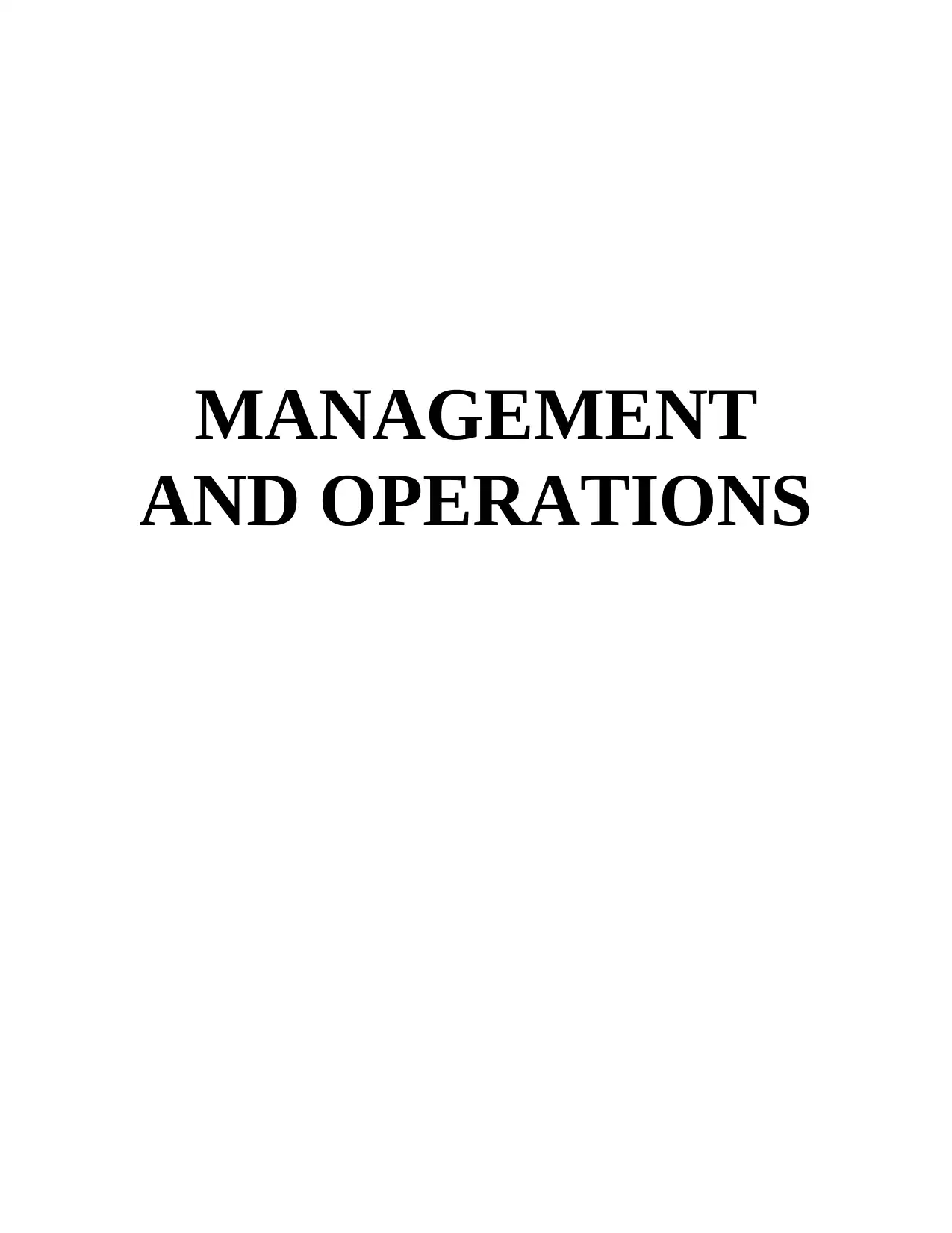
MANAGEMENT
AND OPERATIONS
AND OPERATIONS
Paraphrase This Document
Need a fresh take? Get an instant paraphrase of this document with our AI Paraphraser
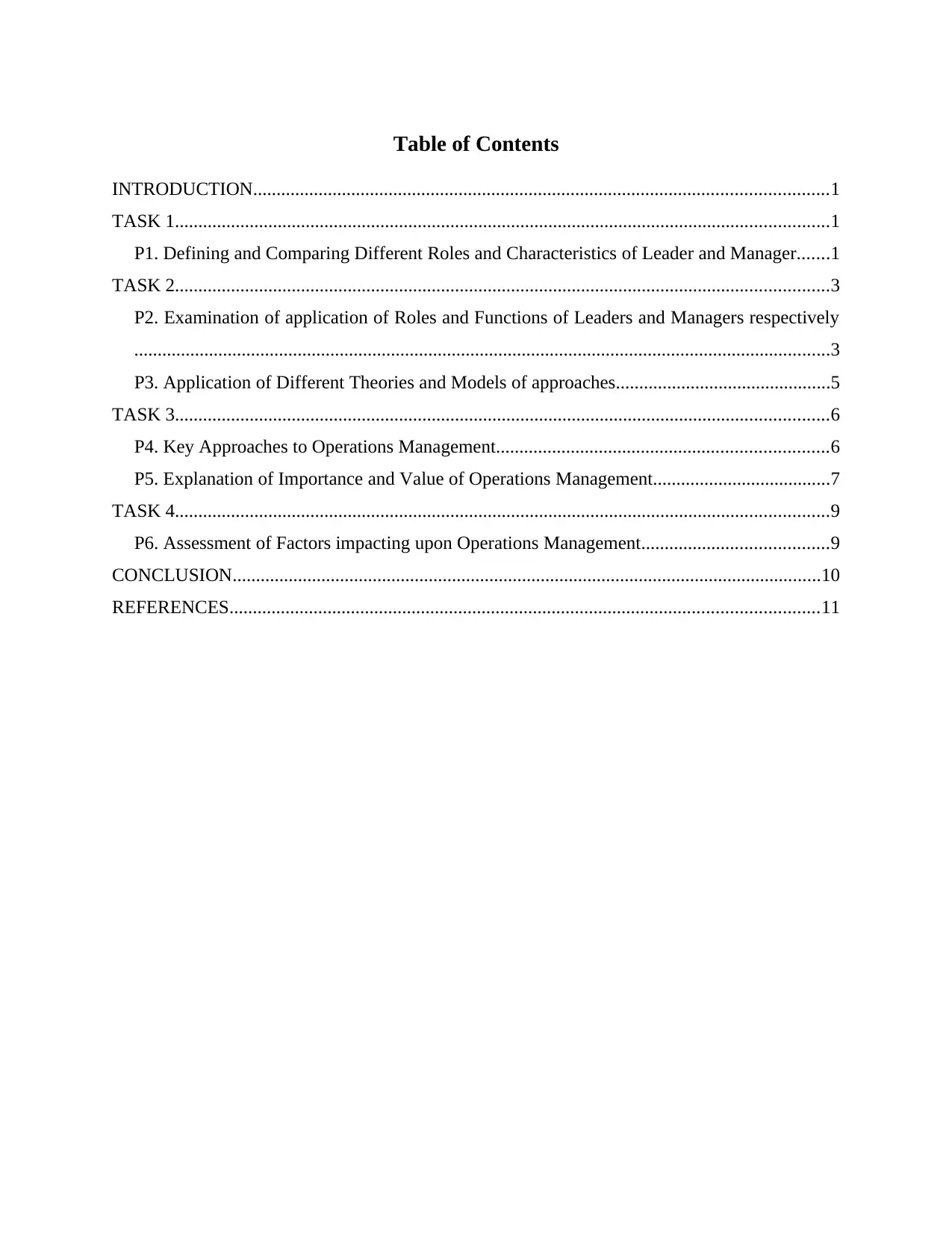
Table of Contents
INTRODUCTION...........................................................................................................................1
TASK 1............................................................................................................................................1
P1. Defining and Comparing Different Roles and Characteristics of Leader and Manager.......1
TASK 2............................................................................................................................................3
P2. Examination of application of Roles and Functions of Leaders and Managers respectively
.....................................................................................................................................................3
P3. Application of Different Theories and Models of approaches..............................................5
TASK 3............................................................................................................................................6
P4. Key Approaches to Operations Management.......................................................................6
P5. Explanation of Importance and Value of Operations Management......................................7
TASK 4............................................................................................................................................9
P6. Assessment of Factors impacting upon Operations Management........................................9
CONCLUSION..............................................................................................................................10
REFERENCES..............................................................................................................................11
INTRODUCTION...........................................................................................................................1
TASK 1............................................................................................................................................1
P1. Defining and Comparing Different Roles and Characteristics of Leader and Manager.......1
TASK 2............................................................................................................................................3
P2. Examination of application of Roles and Functions of Leaders and Managers respectively
.....................................................................................................................................................3
P3. Application of Different Theories and Models of approaches..............................................5
TASK 3............................................................................................................................................6
P4. Key Approaches to Operations Management.......................................................................6
P5. Explanation of Importance and Value of Operations Management......................................7
TASK 4............................................................................................................................................9
P6. Assessment of Factors impacting upon Operations Management........................................9
CONCLUSION..............................................................................................................................10
REFERENCES..............................................................................................................................11
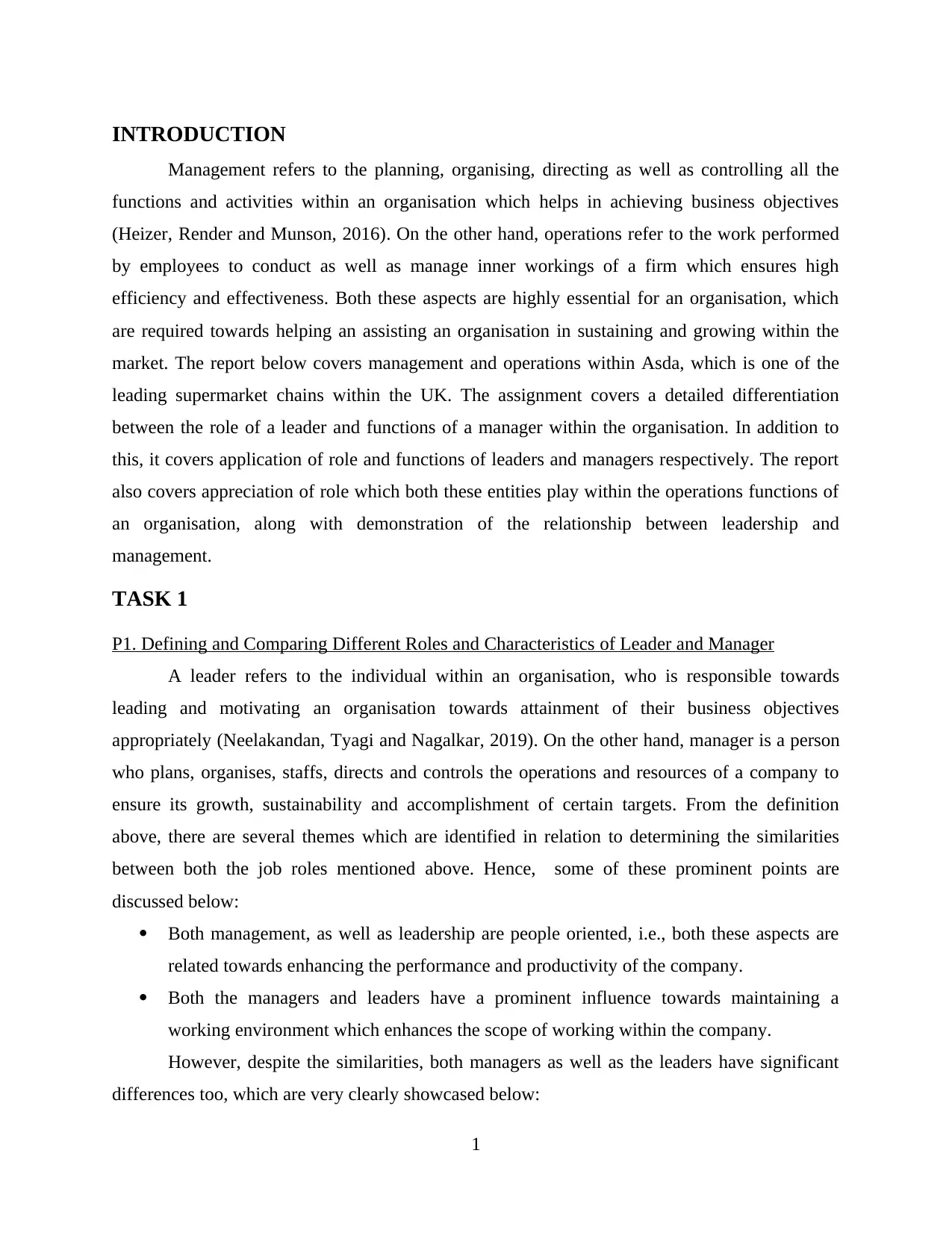
INTRODUCTION
Management refers to the planning, organising, directing as well as controlling all the
functions and activities within an organisation which helps in achieving business objectives
(Heizer, Render and Munson, 2016). On the other hand, operations refer to the work performed
by employees to conduct as well as manage inner workings of a firm which ensures high
efficiency and effectiveness. Both these aspects are highly essential for an organisation, which
are required towards helping an assisting an organisation in sustaining and growing within the
market. The report below covers management and operations within Asda, which is one of the
leading supermarket chains within the UK. The assignment covers a detailed differentiation
between the role of a leader and functions of a manager within the organisation. In addition to
this, it covers application of role and functions of leaders and managers respectively. The report
also covers appreciation of role which both these entities play within the operations functions of
an organisation, along with demonstration of the relationship between leadership and
management.
TASK 1
P1. Defining and Comparing Different Roles and Characteristics of Leader and Manager
A leader refers to the individual within an organisation, who is responsible towards
leading and motivating an organisation towards attainment of their business objectives
appropriately (Neelakandan, Tyagi and Nagalkar, 2019). On the other hand, manager is a person
who plans, organises, staffs, directs and controls the operations and resources of a company to
ensure its growth, sustainability and accomplishment of certain targets. From the definition
above, there are several themes which are identified in relation to determining the similarities
between both the job roles mentioned above. Hence, some of these prominent points are
discussed below:
Both management, as well as leadership are people oriented, i.e., both these aspects are
related towards enhancing the performance and productivity of the company.
Both the managers and leaders have a prominent influence towards maintaining a
working environment which enhances the scope of working within the company.
However, despite the similarities, both managers as well as the leaders have significant
differences too, which are very clearly showcased below:
1
Management refers to the planning, organising, directing as well as controlling all the
functions and activities within an organisation which helps in achieving business objectives
(Heizer, Render and Munson, 2016). On the other hand, operations refer to the work performed
by employees to conduct as well as manage inner workings of a firm which ensures high
efficiency and effectiveness. Both these aspects are highly essential for an organisation, which
are required towards helping an assisting an organisation in sustaining and growing within the
market. The report below covers management and operations within Asda, which is one of the
leading supermarket chains within the UK. The assignment covers a detailed differentiation
between the role of a leader and functions of a manager within the organisation. In addition to
this, it covers application of role and functions of leaders and managers respectively. The report
also covers appreciation of role which both these entities play within the operations functions of
an organisation, along with demonstration of the relationship between leadership and
management.
TASK 1
P1. Defining and Comparing Different Roles and Characteristics of Leader and Manager
A leader refers to the individual within an organisation, who is responsible towards
leading and motivating an organisation towards attainment of their business objectives
appropriately (Neelakandan, Tyagi and Nagalkar, 2019). On the other hand, manager is a person
who plans, organises, staffs, directs and controls the operations and resources of a company to
ensure its growth, sustainability and accomplishment of certain targets. From the definition
above, there are several themes which are identified in relation to determining the similarities
between both the job roles mentioned above. Hence, some of these prominent points are
discussed below:
Both management, as well as leadership are people oriented, i.e., both these aspects are
related towards enhancing the performance and productivity of the company.
Both the managers and leaders have a prominent influence towards maintaining a
working environment which enhances the scope of working within the company.
However, despite the similarities, both managers as well as the leaders have significant
differences too, which are very clearly showcased below:
1
⊘ This is a preview!⊘
Do you want full access?
Subscribe today to unlock all pages.

Trusted by 1+ million students worldwide
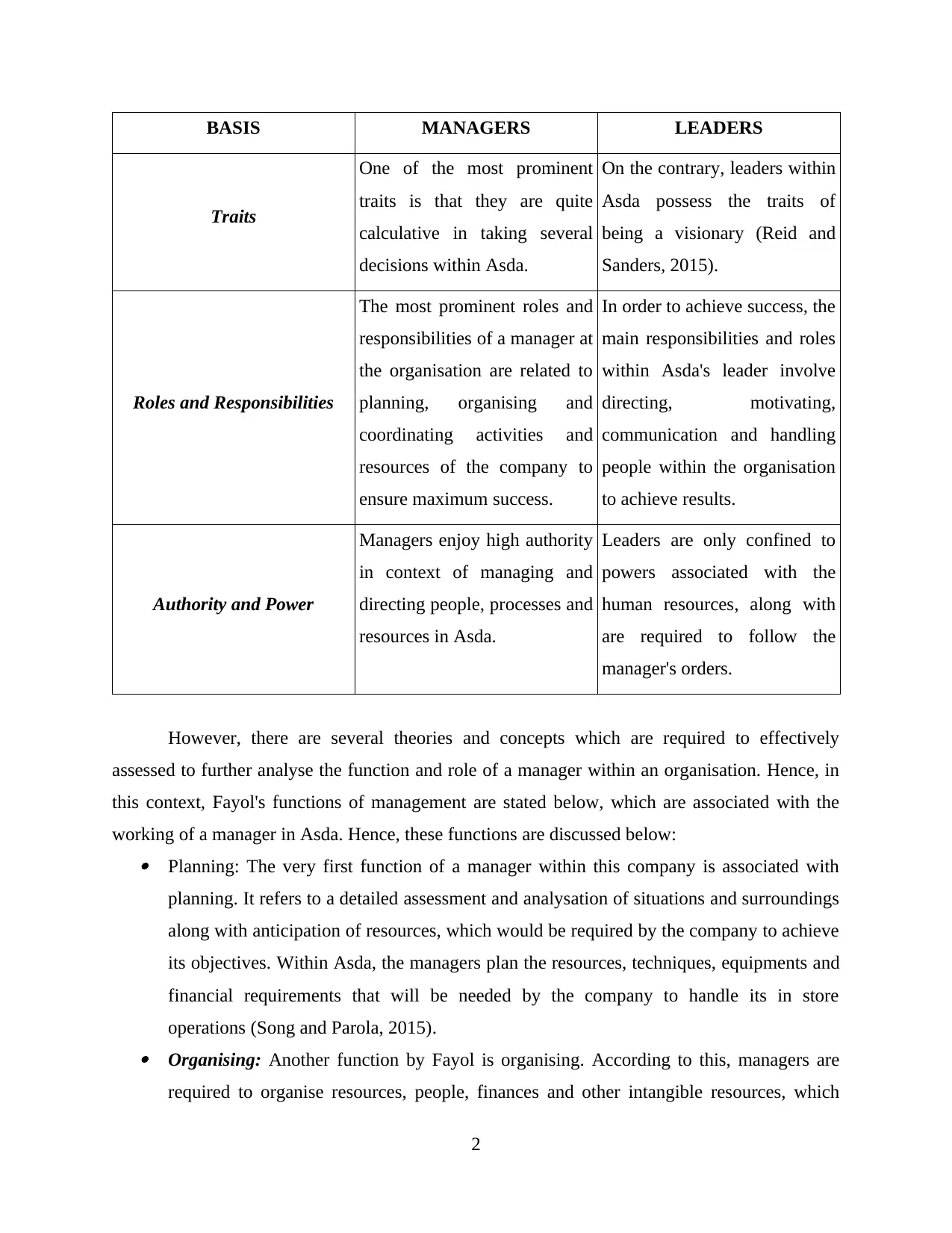
BASIS MANAGERS LEADERS
Traits
One of the most prominent
traits is that they are quite
calculative in taking several
decisions within Asda.
On the contrary, leaders within
Asda possess the traits of
being a visionary (Reid and
Sanders, 2015).
Roles and Responsibilities
The most prominent roles and
responsibilities of a manager at
the organisation are related to
planning, organising and
coordinating activities and
resources of the company to
ensure maximum success.
In order to achieve success, the
main responsibilities and roles
within Asda's leader involve
directing, motivating,
communication and handling
people within the organisation
to achieve results.
Authority and Power
Managers enjoy high authority
in context of managing and
directing people, processes and
resources in Asda.
Leaders are only confined to
powers associated with the
human resources, along with
are required to follow the
manager's orders.
However, there are several theories and concepts which are required to effectively
assessed to further analyse the function and role of a manager within an organisation. Hence, in
this context, Fayol's functions of management are stated below, which are associated with the
working of a manager in Asda. Hence, these functions are discussed below: Planning: The very first function of a manager within this company is associated with
planning. It refers to a detailed assessment and analysation of situations and surroundings
along with anticipation of resources, which would be required by the company to achieve
its objectives. Within Asda, the managers plan the resources, techniques, equipments and
financial requirements that will be needed by the company to handle its in store
operations (Song and Parola, 2015). Organising: Another function by Fayol is organising. According to this, managers are
required to organise resources, people, finances and other intangible resources, which
2
Traits
One of the most prominent
traits is that they are quite
calculative in taking several
decisions within Asda.
On the contrary, leaders within
Asda possess the traits of
being a visionary (Reid and
Sanders, 2015).
Roles and Responsibilities
The most prominent roles and
responsibilities of a manager at
the organisation are related to
planning, organising and
coordinating activities and
resources of the company to
ensure maximum success.
In order to achieve success, the
main responsibilities and roles
within Asda's leader involve
directing, motivating,
communication and handling
people within the organisation
to achieve results.
Authority and Power
Managers enjoy high authority
in context of managing and
directing people, processes and
resources in Asda.
Leaders are only confined to
powers associated with the
human resources, along with
are required to follow the
manager's orders.
However, there are several theories and concepts which are required to effectively
assessed to further analyse the function and role of a manager within an organisation. Hence, in
this context, Fayol's functions of management are stated below, which are associated with the
working of a manager in Asda. Hence, these functions are discussed below: Planning: The very first function of a manager within this company is associated with
planning. It refers to a detailed assessment and analysation of situations and surroundings
along with anticipation of resources, which would be required by the company to achieve
its objectives. Within Asda, the managers plan the resources, techniques, equipments and
financial requirements that will be needed by the company to handle its in store
operations (Song and Parola, 2015). Organising: Another function by Fayol is organising. According to this, managers are
required to organise resources, people, finances and other intangible resources, which
2
Paraphrase This Document
Need a fresh take? Get an instant paraphrase of this document with our AI Paraphraser
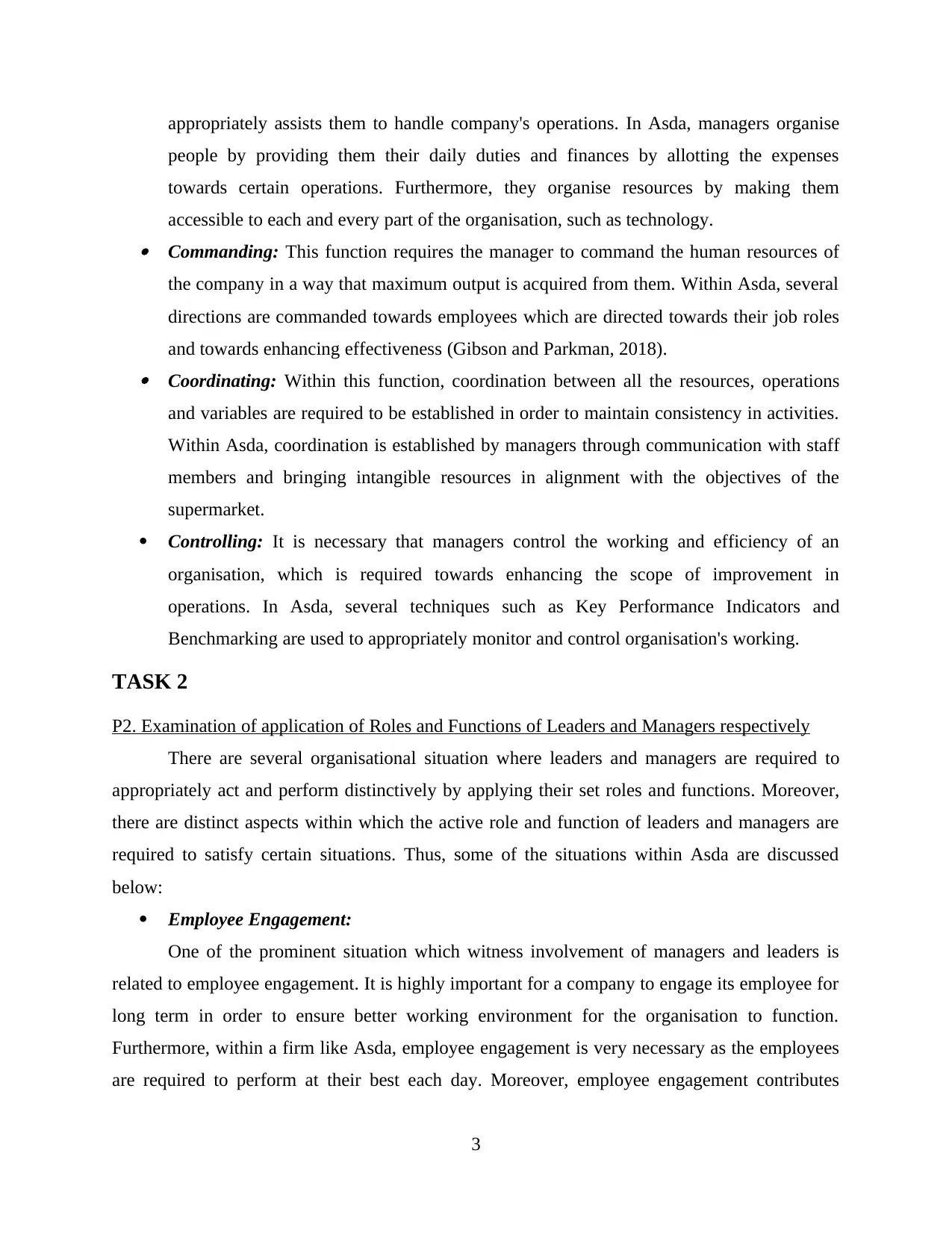
appropriately assists them to handle company's operations. In Asda, managers organise
people by providing them their daily duties and finances by allotting the expenses
towards certain operations. Furthermore, they organise resources by making them
accessible to each and every part of the organisation, such as technology. Commanding: This function requires the manager to command the human resources of
the company in a way that maximum output is acquired from them. Within Asda, several
directions are commanded towards employees which are directed towards their job roles
and towards enhancing effectiveness (Gibson and Parkman, 2018). Coordinating: Within this function, coordination between all the resources, operations
and variables are required to be established in order to maintain consistency in activities.
Within Asda, coordination is established by managers through communication with staff
members and bringing intangible resources in alignment with the objectives of the
supermarket.
Controlling: It is necessary that managers control the working and efficiency of an
organisation, which is required towards enhancing the scope of improvement in
operations. In Asda, several techniques such as Key Performance Indicators and
Benchmarking are used to appropriately monitor and control organisation's working.
TASK 2
P2. Examination of application of Roles and Functions of Leaders and Managers respectively
There are several organisational situation where leaders and managers are required to
appropriately act and perform distinctively by applying their set roles and functions. Moreover,
there are distinct aspects within which the active role and function of leaders and managers are
required to satisfy certain situations. Thus, some of the situations within Asda are discussed
below:
Employee Engagement:
One of the prominent situation which witness involvement of managers and leaders is
related to employee engagement. It is highly important for a company to engage its employee for
long term in order to ensure better working environment for the organisation to function.
Furthermore, within a firm like Asda, employee engagement is very necessary as the employees
are required to perform at their best each day. Moreover, employee engagement contributes
3
people by providing them their daily duties and finances by allotting the expenses
towards certain operations. Furthermore, they organise resources by making them
accessible to each and every part of the organisation, such as technology. Commanding: This function requires the manager to command the human resources of
the company in a way that maximum output is acquired from them. Within Asda, several
directions are commanded towards employees which are directed towards their job roles
and towards enhancing effectiveness (Gibson and Parkman, 2018). Coordinating: Within this function, coordination between all the resources, operations
and variables are required to be established in order to maintain consistency in activities.
Within Asda, coordination is established by managers through communication with staff
members and bringing intangible resources in alignment with the objectives of the
supermarket.
Controlling: It is necessary that managers control the working and efficiency of an
organisation, which is required towards enhancing the scope of improvement in
operations. In Asda, several techniques such as Key Performance Indicators and
Benchmarking are used to appropriately monitor and control organisation's working.
TASK 2
P2. Examination of application of Roles and Functions of Leaders and Managers respectively
There are several organisational situation where leaders and managers are required to
appropriately act and perform distinctively by applying their set roles and functions. Moreover,
there are distinct aspects within which the active role and function of leaders and managers are
required to satisfy certain situations. Thus, some of the situations within Asda are discussed
below:
Employee Engagement:
One of the prominent situation which witness involvement of managers and leaders is
related to employee engagement. It is highly important for a company to engage its employee for
long term in order to ensure better working environment for the organisation to function.
Furthermore, within a firm like Asda, employee engagement is very necessary as the employees
are required to perform at their best each day. Moreover, employee engagement contributes
3
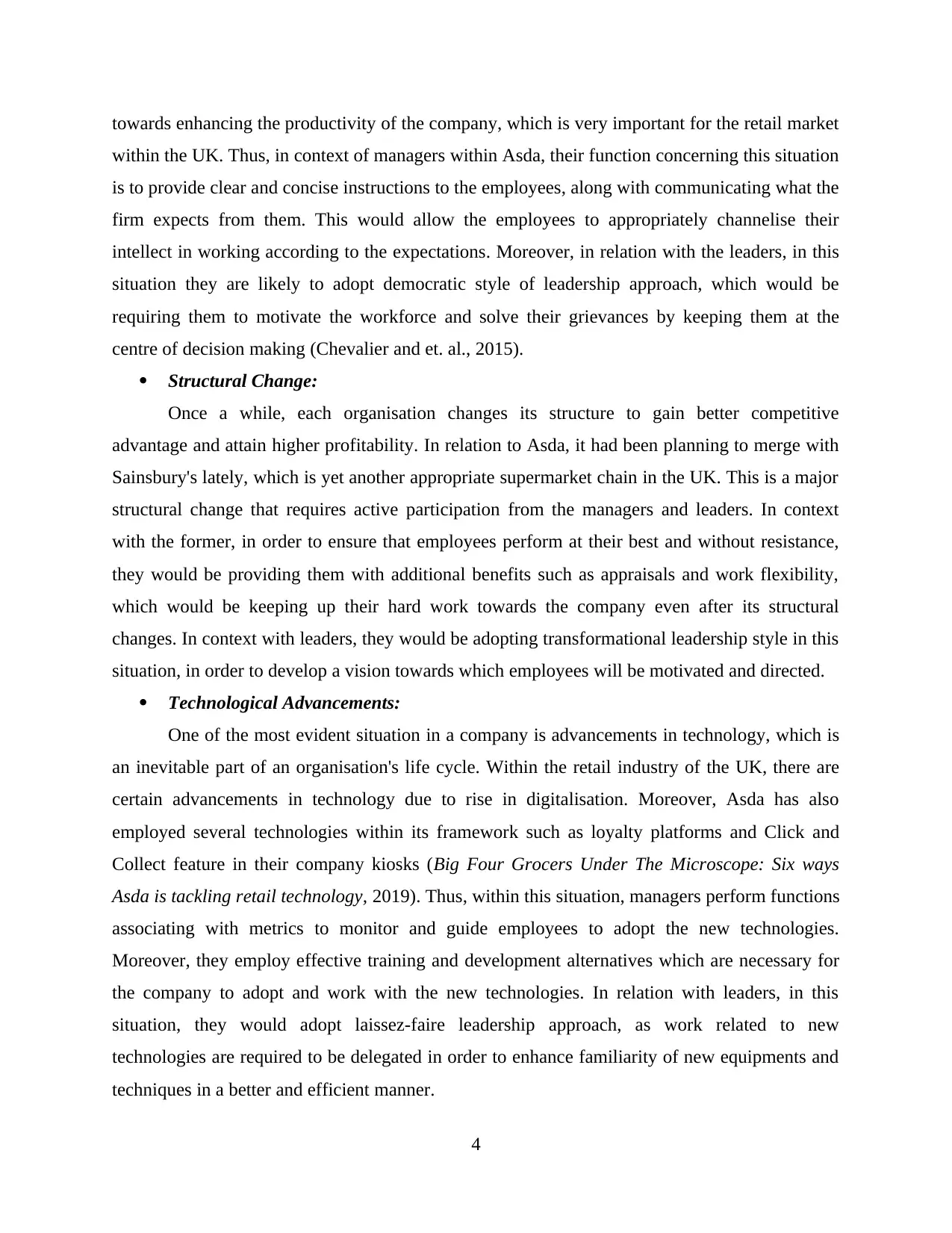
towards enhancing the productivity of the company, which is very important for the retail market
within the UK. Thus, in context of managers within Asda, their function concerning this situation
is to provide clear and concise instructions to the employees, along with communicating what the
firm expects from them. This would allow the employees to appropriately channelise their
intellect in working according to the expectations. Moreover, in relation with the leaders, in this
situation they are likely to adopt democratic style of leadership approach, which would be
requiring them to motivate the workforce and solve their grievances by keeping them at the
centre of decision making (Chevalier and et. al., 2015).
Structural Change:
Once a while, each organisation changes its structure to gain better competitive
advantage and attain higher profitability. In relation to Asda, it had been planning to merge with
Sainsbury's lately, which is yet another appropriate supermarket chain in the UK. This is a major
structural change that requires active participation from the managers and leaders. In context
with the former, in order to ensure that employees perform at their best and without resistance,
they would be providing them with additional benefits such as appraisals and work flexibility,
which would be keeping up their hard work towards the company even after its structural
changes. In context with leaders, they would be adopting transformational leadership style in this
situation, in order to develop a vision towards which employees will be motivated and directed.
Technological Advancements:
One of the most evident situation in a company is advancements in technology, which is
an inevitable part of an organisation's life cycle. Within the retail industry of the UK, there are
certain advancements in technology due to rise in digitalisation. Moreover, Asda has also
employed several technologies within its framework such as loyalty platforms and Click and
Collect feature in their company kiosks (Big Four Grocers Under The Microscope: Six ways
Asda is tackling retail technology, 2019). Thus, within this situation, managers perform functions
associating with metrics to monitor and guide employees to adopt the new technologies.
Moreover, they employ effective training and development alternatives which are necessary for
the company to adopt and work with the new technologies. In relation with leaders, in this
situation, they would adopt laissez-faire leadership approach, as work related to new
technologies are required to be delegated in order to enhance familiarity of new equipments and
techniques in a better and efficient manner.
4
within the UK. Thus, in context of managers within Asda, their function concerning this situation
is to provide clear and concise instructions to the employees, along with communicating what the
firm expects from them. This would allow the employees to appropriately channelise their
intellect in working according to the expectations. Moreover, in relation with the leaders, in this
situation they are likely to adopt democratic style of leadership approach, which would be
requiring them to motivate the workforce and solve their grievances by keeping them at the
centre of decision making (Chevalier and et. al., 2015).
Structural Change:
Once a while, each organisation changes its structure to gain better competitive
advantage and attain higher profitability. In relation to Asda, it had been planning to merge with
Sainsbury's lately, which is yet another appropriate supermarket chain in the UK. This is a major
structural change that requires active participation from the managers and leaders. In context
with the former, in order to ensure that employees perform at their best and without resistance,
they would be providing them with additional benefits such as appraisals and work flexibility,
which would be keeping up their hard work towards the company even after its structural
changes. In context with leaders, they would be adopting transformational leadership style in this
situation, in order to develop a vision towards which employees will be motivated and directed.
Technological Advancements:
One of the most evident situation in a company is advancements in technology, which is
an inevitable part of an organisation's life cycle. Within the retail industry of the UK, there are
certain advancements in technology due to rise in digitalisation. Moreover, Asda has also
employed several technologies within its framework such as loyalty platforms and Click and
Collect feature in their company kiosks (Big Four Grocers Under The Microscope: Six ways
Asda is tackling retail technology, 2019). Thus, within this situation, managers perform functions
associating with metrics to monitor and guide employees to adopt the new technologies.
Moreover, they employ effective training and development alternatives which are necessary for
the company to adopt and work with the new technologies. In relation with leaders, in this
situation, they would adopt laissez-faire leadership approach, as work related to new
technologies are required to be delegated in order to enhance familiarity of new equipments and
techniques in a better and efficient manner.
4
⊘ This is a preview!⊘
Do you want full access?
Subscribe today to unlock all pages.

Trusted by 1+ million students worldwide
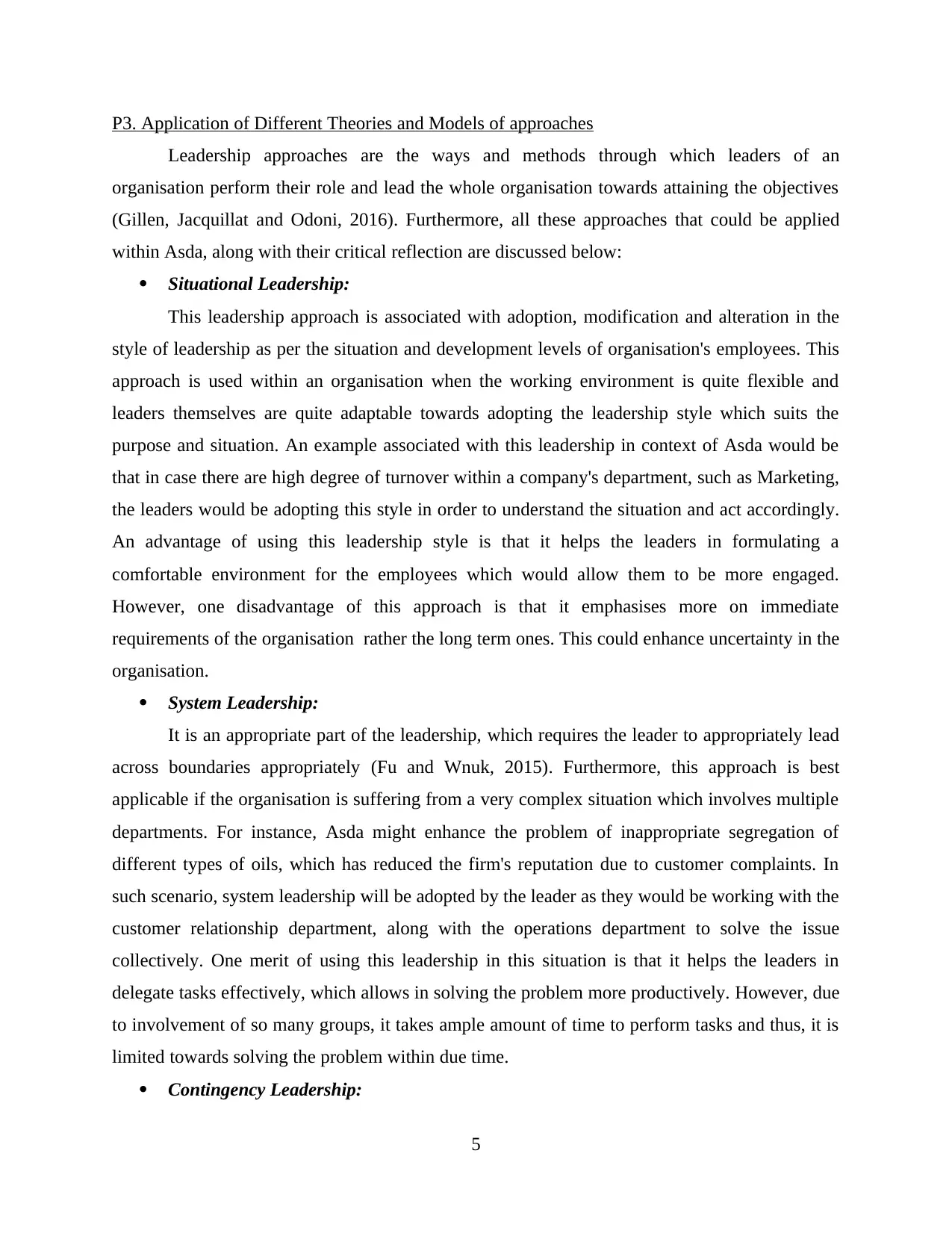
P3. Application of Different Theories and Models of approaches
Leadership approaches are the ways and methods through which leaders of an
organisation perform their role and lead the whole organisation towards attaining the objectives
(Gillen, Jacquillat and Odoni, 2016). Furthermore, all these approaches that could be applied
within Asda, along with their critical reflection are discussed below:
Situational Leadership:
This leadership approach is associated with adoption, modification and alteration in the
style of leadership as per the situation and development levels of organisation's employees. This
approach is used within an organisation when the working environment is quite flexible and
leaders themselves are quite adaptable towards adopting the leadership style which suits the
purpose and situation. An example associated with this leadership in context of Asda would be
that in case there are high degree of turnover within a company's department, such as Marketing,
the leaders would be adopting this style in order to understand the situation and act accordingly.
An advantage of using this leadership style is that it helps the leaders in formulating a
comfortable environment for the employees which would allow them to be more engaged.
However, one disadvantage of this approach is that it emphasises more on immediate
requirements of the organisation rather the long term ones. This could enhance uncertainty in the
organisation.
System Leadership:
It is an appropriate part of the leadership, which requires the leader to appropriately lead
across boundaries appropriately (Fu and Wnuk, 2015). Furthermore, this approach is best
applicable if the organisation is suffering from a very complex situation which involves multiple
departments. For instance, Asda might enhance the problem of inappropriate segregation of
different types of oils, which has reduced the firm's reputation due to customer complaints. In
such scenario, system leadership will be adopted by the leader as they would be working with the
customer relationship department, along with the operations department to solve the issue
collectively. One merit of using this leadership in this situation is that it helps the leaders in
delegate tasks effectively, which allows in solving the problem more productively. However, due
to involvement of so many groups, it takes ample amount of time to perform tasks and thus, it is
limited towards solving the problem within due time.
Contingency Leadership:
5
Leadership approaches are the ways and methods through which leaders of an
organisation perform their role and lead the whole organisation towards attaining the objectives
(Gillen, Jacquillat and Odoni, 2016). Furthermore, all these approaches that could be applied
within Asda, along with their critical reflection are discussed below:
Situational Leadership:
This leadership approach is associated with adoption, modification and alteration in the
style of leadership as per the situation and development levels of organisation's employees. This
approach is used within an organisation when the working environment is quite flexible and
leaders themselves are quite adaptable towards adopting the leadership style which suits the
purpose and situation. An example associated with this leadership in context of Asda would be
that in case there are high degree of turnover within a company's department, such as Marketing,
the leaders would be adopting this style in order to understand the situation and act accordingly.
An advantage of using this leadership style is that it helps the leaders in formulating a
comfortable environment for the employees which would allow them to be more engaged.
However, one disadvantage of this approach is that it emphasises more on immediate
requirements of the organisation rather the long term ones. This could enhance uncertainty in the
organisation.
System Leadership:
It is an appropriate part of the leadership, which requires the leader to appropriately lead
across boundaries appropriately (Fu and Wnuk, 2015). Furthermore, this approach is best
applicable if the organisation is suffering from a very complex situation which involves multiple
departments. For instance, Asda might enhance the problem of inappropriate segregation of
different types of oils, which has reduced the firm's reputation due to customer complaints. In
such scenario, system leadership will be adopted by the leader as they would be working with the
customer relationship department, along with the operations department to solve the issue
collectively. One merit of using this leadership in this situation is that it helps the leaders in
delegate tasks effectively, which allows in solving the problem more productively. However, due
to involvement of so many groups, it takes ample amount of time to perform tasks and thus, it is
limited towards solving the problem within due time.
Contingency Leadership:
5
Paraphrase This Document
Need a fresh take? Get an instant paraphrase of this document with our AI Paraphraser
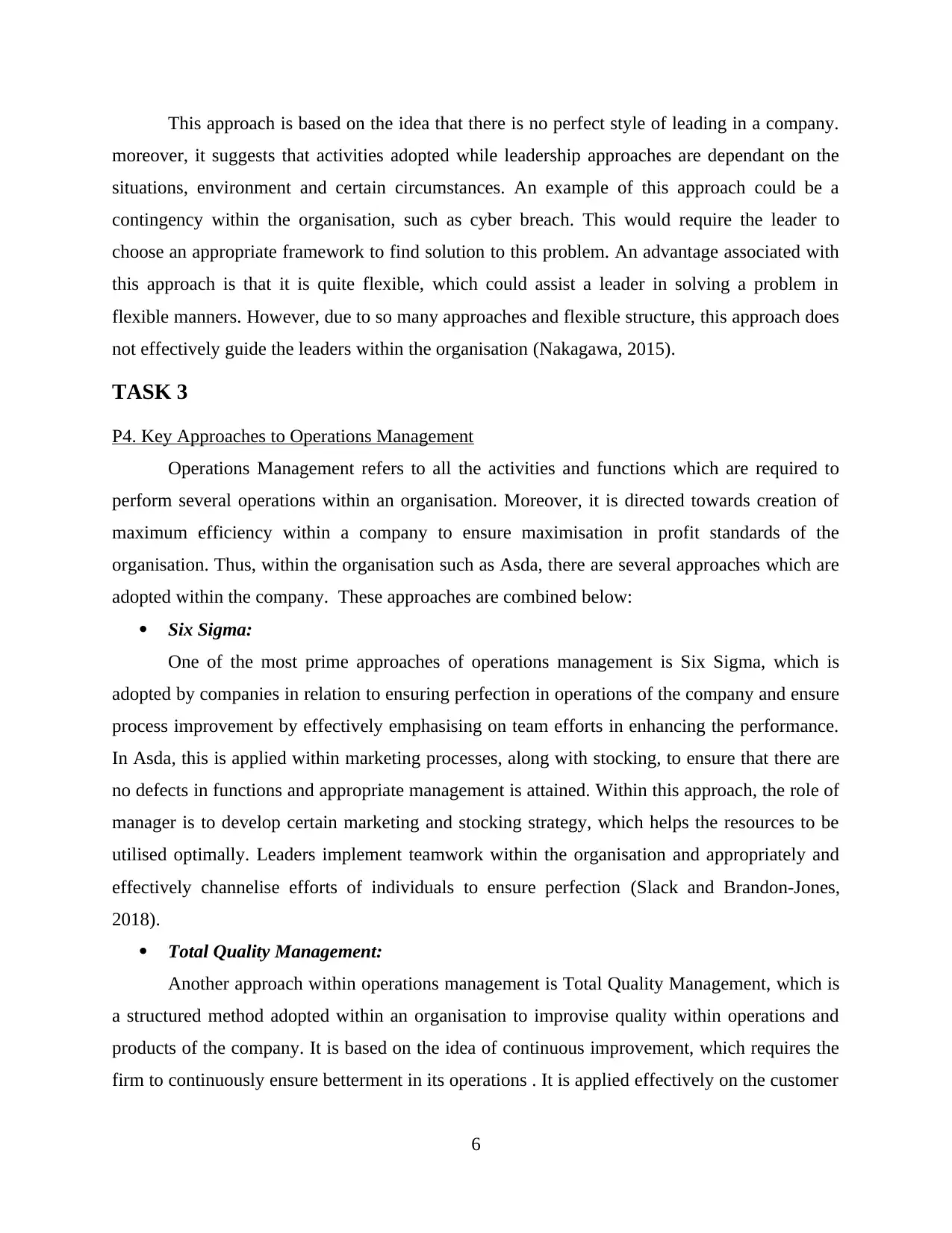
This approach is based on the idea that there is no perfect style of leading in a company.
moreover, it suggests that activities adopted while leadership approaches are dependant on the
situations, environment and certain circumstances. An example of this approach could be a
contingency within the organisation, such as cyber breach. This would require the leader to
choose an appropriate framework to find solution to this problem. An advantage associated with
this approach is that it is quite flexible, which could assist a leader in solving a problem in
flexible manners. However, due to so many approaches and flexible structure, this approach does
not effectively guide the leaders within the organisation (Nakagawa, 2015).
TASK 3
P4. Key Approaches to Operations Management
Operations Management refers to all the activities and functions which are required to
perform several operations within an organisation. Moreover, it is directed towards creation of
maximum efficiency within a company to ensure maximisation in profit standards of the
organisation. Thus, within the organisation such as Asda, there are several approaches which are
adopted within the company. These approaches are combined below:
Six Sigma:
One of the most prime approaches of operations management is Six Sigma, which is
adopted by companies in relation to ensuring perfection in operations of the company and ensure
process improvement by effectively emphasising on team efforts in enhancing the performance.
In Asda, this is applied within marketing processes, along with stocking, to ensure that there are
no defects in functions and appropriate management is attained. Within this approach, the role of
manager is to develop certain marketing and stocking strategy, which helps the resources to be
utilised optimally. Leaders implement teamwork within the organisation and appropriately and
effectively channelise efforts of individuals to ensure perfection (Slack and Brandon-Jones,
2018).
Total Quality Management:
Another approach within operations management is Total Quality Management, which is
a structured method adopted within an organisation to improvise quality within operations and
products of the company. It is based on the idea of continuous improvement, which requires the
firm to continuously ensure betterment in its operations . It is applied effectively on the customer
6
moreover, it suggests that activities adopted while leadership approaches are dependant on the
situations, environment and certain circumstances. An example of this approach could be a
contingency within the organisation, such as cyber breach. This would require the leader to
choose an appropriate framework to find solution to this problem. An advantage associated with
this approach is that it is quite flexible, which could assist a leader in solving a problem in
flexible manners. However, due to so many approaches and flexible structure, this approach does
not effectively guide the leaders within the organisation (Nakagawa, 2015).
TASK 3
P4. Key Approaches to Operations Management
Operations Management refers to all the activities and functions which are required to
perform several operations within an organisation. Moreover, it is directed towards creation of
maximum efficiency within a company to ensure maximisation in profit standards of the
organisation. Thus, within the organisation such as Asda, there are several approaches which are
adopted within the company. These approaches are combined below:
Six Sigma:
One of the most prime approaches of operations management is Six Sigma, which is
adopted by companies in relation to ensuring perfection in operations of the company and ensure
process improvement by effectively emphasising on team efforts in enhancing the performance.
In Asda, this is applied within marketing processes, along with stocking, to ensure that there are
no defects in functions and appropriate management is attained. Within this approach, the role of
manager is to develop certain marketing and stocking strategy, which helps the resources to be
utilised optimally. Leaders implement teamwork within the organisation and appropriately and
effectively channelise efforts of individuals to ensure perfection (Slack and Brandon-Jones,
2018).
Total Quality Management:
Another approach within operations management is Total Quality Management, which is
a structured method adopted within an organisation to improvise quality within operations and
products of the company. It is based on the idea of continuous improvement, which requires the
firm to continuously ensure betterment in its operations . It is applied effectively on the customer
6
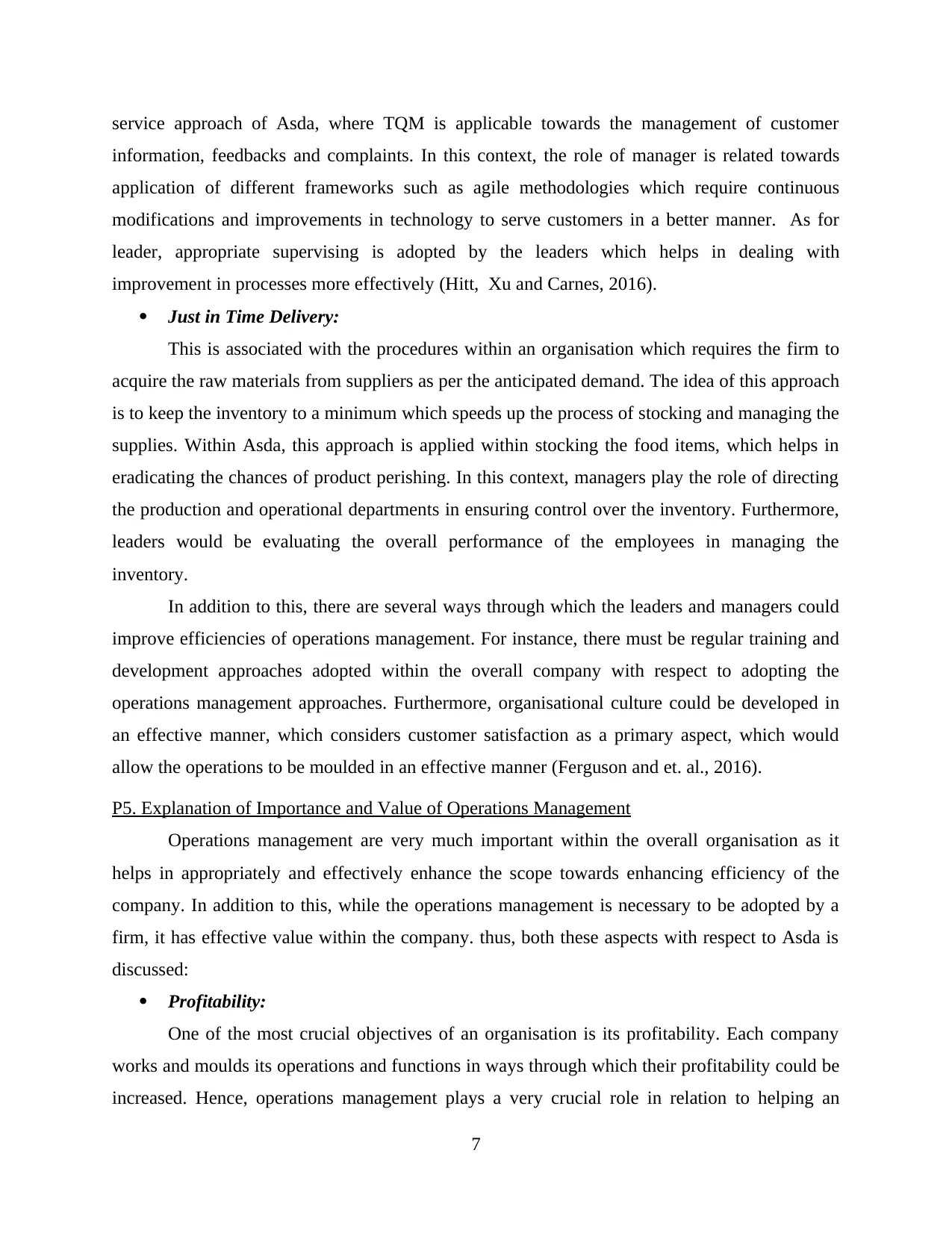
service approach of Asda, where TQM is applicable towards the management of customer
information, feedbacks and complaints. In this context, the role of manager is related towards
application of different frameworks such as agile methodologies which require continuous
modifications and improvements in technology to serve customers in a better manner. As for
leader, appropriate supervising is adopted by the leaders which helps in dealing with
improvement in processes more effectively (Hitt, Xu and Carnes, 2016).
Just in Time Delivery:
This is associated with the procedures within an organisation which requires the firm to
acquire the raw materials from suppliers as per the anticipated demand. The idea of this approach
is to keep the inventory to a minimum which speeds up the process of stocking and managing the
supplies. Within Asda, this approach is applied within stocking the food items, which helps in
eradicating the chances of product perishing. In this context, managers play the role of directing
the production and operational departments in ensuring control over the inventory. Furthermore,
leaders would be evaluating the overall performance of the employees in managing the
inventory.
In addition to this, there are several ways through which the leaders and managers could
improve efficiencies of operations management. For instance, there must be regular training and
development approaches adopted within the overall company with respect to adopting the
operations management approaches. Furthermore, organisational culture could be developed in
an effective manner, which considers customer satisfaction as a primary aspect, which would
allow the operations to be moulded in an effective manner (Ferguson and et. al., 2016).
P5. Explanation of Importance and Value of Operations Management
Operations management are very much important within the overall organisation as it
helps in appropriately and effectively enhance the scope towards enhancing efficiency of the
company. In addition to this, while the operations management is necessary to be adopted by a
firm, it has effective value within the company. thus, both these aspects with respect to Asda is
discussed:
Profitability:
One of the most crucial objectives of an organisation is its profitability. Each company
works and moulds its operations and functions in ways through which their profitability could be
increased. Hence, operations management plays a very crucial role in relation to helping an
7
information, feedbacks and complaints. In this context, the role of manager is related towards
application of different frameworks such as agile methodologies which require continuous
modifications and improvements in technology to serve customers in a better manner. As for
leader, appropriate supervising is adopted by the leaders which helps in dealing with
improvement in processes more effectively (Hitt, Xu and Carnes, 2016).
Just in Time Delivery:
This is associated with the procedures within an organisation which requires the firm to
acquire the raw materials from suppliers as per the anticipated demand. The idea of this approach
is to keep the inventory to a minimum which speeds up the process of stocking and managing the
supplies. Within Asda, this approach is applied within stocking the food items, which helps in
eradicating the chances of product perishing. In this context, managers play the role of directing
the production and operational departments in ensuring control over the inventory. Furthermore,
leaders would be evaluating the overall performance of the employees in managing the
inventory.
In addition to this, there are several ways through which the leaders and managers could
improve efficiencies of operations management. For instance, there must be regular training and
development approaches adopted within the overall company with respect to adopting the
operations management approaches. Furthermore, organisational culture could be developed in
an effective manner, which considers customer satisfaction as a primary aspect, which would
allow the operations to be moulded in an effective manner (Ferguson and et. al., 2016).
P5. Explanation of Importance and Value of Operations Management
Operations management are very much important within the overall organisation as it
helps in appropriately and effectively enhance the scope towards enhancing efficiency of the
company. In addition to this, while the operations management is necessary to be adopted by a
firm, it has effective value within the company. thus, both these aspects with respect to Asda is
discussed:
Profitability:
One of the most crucial objectives of an organisation is its profitability. Each company
works and moulds its operations and functions in ways through which their profitability could be
increased. Hence, operations management plays a very crucial role in relation to helping an
7
⊘ This is a preview!⊘
Do you want full access?
Subscribe today to unlock all pages.

Trusted by 1+ million students worldwide
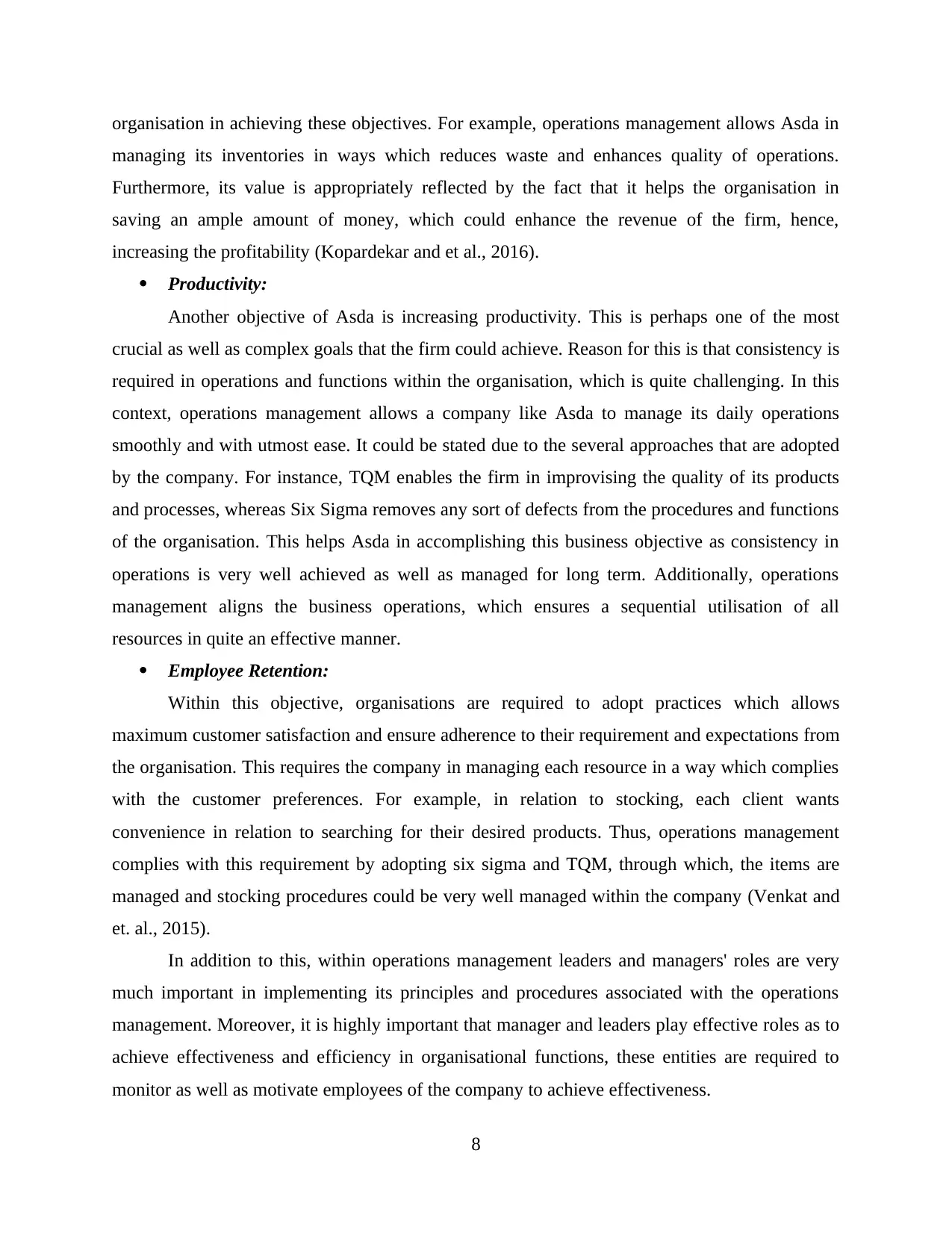
organisation in achieving these objectives. For example, operations management allows Asda in
managing its inventories in ways which reduces waste and enhances quality of operations.
Furthermore, its value is appropriately reflected by the fact that it helps the organisation in
saving an ample amount of money, which could enhance the revenue of the firm, hence,
increasing the profitability (Kopardekar and et al., 2016).
Productivity:
Another objective of Asda is increasing productivity. This is perhaps one of the most
crucial as well as complex goals that the firm could achieve. Reason for this is that consistency is
required in operations and functions within the organisation, which is quite challenging. In this
context, operations management allows a company like Asda to manage its daily operations
smoothly and with utmost ease. It could be stated due to the several approaches that are adopted
by the company. For instance, TQM enables the firm in improvising the quality of its products
and processes, whereas Six Sigma removes any sort of defects from the procedures and functions
of the organisation. This helps Asda in accomplishing this business objective as consistency in
operations is very well achieved as well as managed for long term. Additionally, operations
management aligns the business operations, which ensures a sequential utilisation of all
resources in quite an effective manner.
Employee Retention:
Within this objective, organisations are required to adopt practices which allows
maximum customer satisfaction and ensure adherence to their requirement and expectations from
the organisation. This requires the company in managing each resource in a way which complies
with the customer preferences. For example, in relation to stocking, each client wants
convenience in relation to searching for their desired products. Thus, operations management
complies with this requirement by adopting six sigma and TQM, through which, the items are
managed and stocking procedures could be very well managed within the company (Venkat and
et. al., 2015).
In addition to this, within operations management leaders and managers' roles are very
much important in implementing its principles and procedures associated with the operations
management. Moreover, it is highly important that manager and leaders play effective roles as to
achieve effectiveness and efficiency in organisational functions, these entities are required to
monitor as well as motivate employees of the company to achieve effectiveness.
8
managing its inventories in ways which reduces waste and enhances quality of operations.
Furthermore, its value is appropriately reflected by the fact that it helps the organisation in
saving an ample amount of money, which could enhance the revenue of the firm, hence,
increasing the profitability (Kopardekar and et al., 2016).
Productivity:
Another objective of Asda is increasing productivity. This is perhaps one of the most
crucial as well as complex goals that the firm could achieve. Reason for this is that consistency is
required in operations and functions within the organisation, which is quite challenging. In this
context, operations management allows a company like Asda to manage its daily operations
smoothly and with utmost ease. It could be stated due to the several approaches that are adopted
by the company. For instance, TQM enables the firm in improvising the quality of its products
and processes, whereas Six Sigma removes any sort of defects from the procedures and functions
of the organisation. This helps Asda in accomplishing this business objective as consistency in
operations is very well achieved as well as managed for long term. Additionally, operations
management aligns the business operations, which ensures a sequential utilisation of all
resources in quite an effective manner.
Employee Retention:
Within this objective, organisations are required to adopt practices which allows
maximum customer satisfaction and ensure adherence to their requirement and expectations from
the organisation. This requires the company in managing each resource in a way which complies
with the customer preferences. For example, in relation to stocking, each client wants
convenience in relation to searching for their desired products. Thus, operations management
complies with this requirement by adopting six sigma and TQM, through which, the items are
managed and stocking procedures could be very well managed within the company (Venkat and
et. al., 2015).
In addition to this, within operations management leaders and managers' roles are very
much important in implementing its principles and procedures associated with the operations
management. Moreover, it is highly important that manager and leaders play effective roles as to
achieve effectiveness and efficiency in organisational functions, these entities are required to
monitor as well as motivate employees of the company to achieve effectiveness.
8
Paraphrase This Document
Need a fresh take? Get an instant paraphrase of this document with our AI Paraphraser
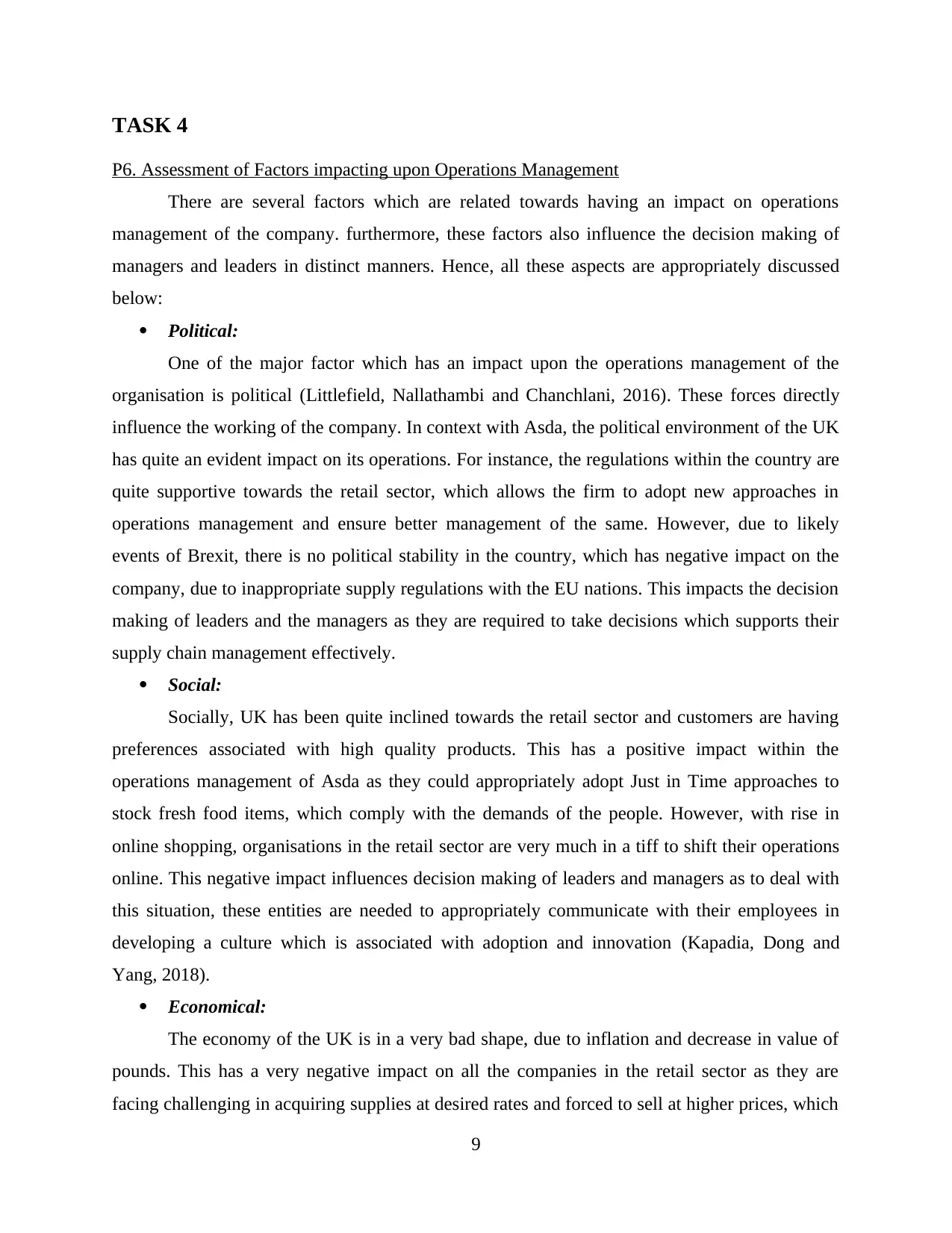
TASK 4
P6. Assessment of Factors impacting upon Operations Management
There are several factors which are related towards having an impact on operations
management of the company. furthermore, these factors also influence the decision making of
managers and leaders in distinct manners. Hence, all these aspects are appropriately discussed
below:
Political:
One of the major factor which has an impact upon the operations management of the
organisation is political (Littlefield, Nallathambi and Chanchlani, 2016). These forces directly
influence the working of the company. In context with Asda, the political environment of the UK
has quite an evident impact on its operations. For instance, the regulations within the country are
quite supportive towards the retail sector, which allows the firm to adopt new approaches in
operations management and ensure better management of the same. However, due to likely
events of Brexit, there is no political stability in the country, which has negative impact on the
company, due to inappropriate supply regulations with the EU nations. This impacts the decision
making of leaders and the managers as they are required to take decisions which supports their
supply chain management effectively.
Social:
Socially, UK has been quite inclined towards the retail sector and customers are having
preferences associated with high quality products. This has a positive impact within the
operations management of Asda as they could appropriately adopt Just in Time approaches to
stock fresh food items, which comply with the demands of the people. However, with rise in
online shopping, organisations in the retail sector are very much in a tiff to shift their operations
online. This negative impact influences decision making of leaders and managers as to deal with
this situation, these entities are needed to appropriately communicate with their employees in
developing a culture which is associated with adoption and innovation (Kapadia, Dong and
Yang, 2018).
Economical:
The economy of the UK is in a very bad shape, due to inflation and decrease in value of
pounds. This has a very negative impact on all the companies in the retail sector as they are
facing challenging in acquiring supplies at desired rates and forced to sell at higher prices, which
9
P6. Assessment of Factors impacting upon Operations Management
There are several factors which are related towards having an impact on operations
management of the company. furthermore, these factors also influence the decision making of
managers and leaders in distinct manners. Hence, all these aspects are appropriately discussed
below:
Political:
One of the major factor which has an impact upon the operations management of the
organisation is political (Littlefield, Nallathambi and Chanchlani, 2016). These forces directly
influence the working of the company. In context with Asda, the political environment of the UK
has quite an evident impact on its operations. For instance, the regulations within the country are
quite supportive towards the retail sector, which allows the firm to adopt new approaches in
operations management and ensure better management of the same. However, due to likely
events of Brexit, there is no political stability in the country, which has negative impact on the
company, due to inappropriate supply regulations with the EU nations. This impacts the decision
making of leaders and the managers as they are required to take decisions which supports their
supply chain management effectively.
Social:
Socially, UK has been quite inclined towards the retail sector and customers are having
preferences associated with high quality products. This has a positive impact within the
operations management of Asda as they could appropriately adopt Just in Time approaches to
stock fresh food items, which comply with the demands of the people. However, with rise in
online shopping, organisations in the retail sector are very much in a tiff to shift their operations
online. This negative impact influences decision making of leaders and managers as to deal with
this situation, these entities are needed to appropriately communicate with their employees in
developing a culture which is associated with adoption and innovation (Kapadia, Dong and
Yang, 2018).
Economical:
The economy of the UK is in a very bad shape, due to inflation and decrease in value of
pounds. This has a very negative impact on all the companies in the retail sector as they are
facing challenging in acquiring supplies at desired rates and forced to sell at higher prices, which
9
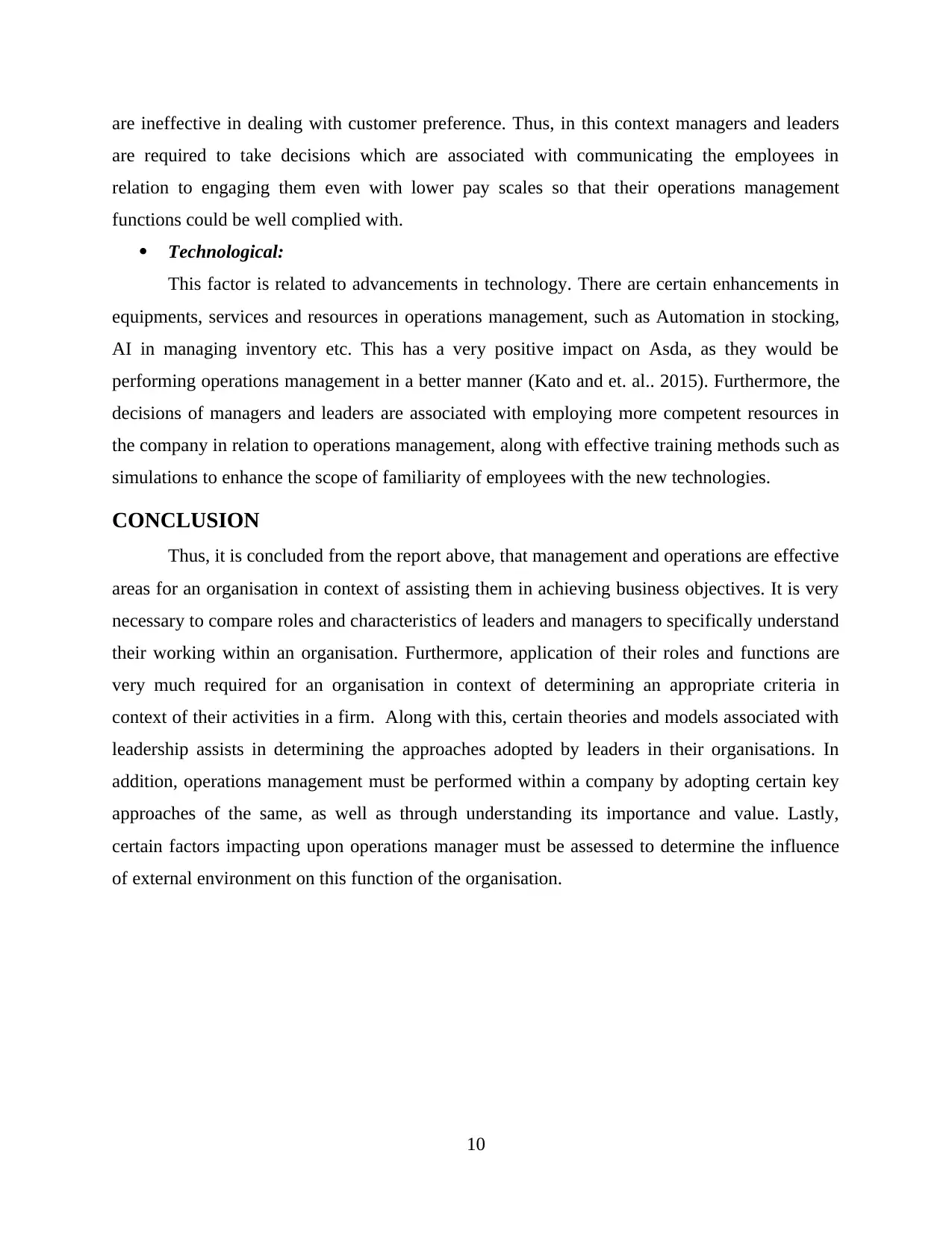
are ineffective in dealing with customer preference. Thus, in this context managers and leaders
are required to take decisions which are associated with communicating the employees in
relation to engaging them even with lower pay scales so that their operations management
functions could be well complied with.
Technological:
This factor is related to advancements in technology. There are certain enhancements in
equipments, services and resources in operations management, such as Automation in stocking,
AI in managing inventory etc. This has a very positive impact on Asda, as they would be
performing operations management in a better manner (Kato and et. al.. 2015). Furthermore, the
decisions of managers and leaders are associated with employing more competent resources in
the company in relation to operations management, along with effective training methods such as
simulations to enhance the scope of familiarity of employees with the new technologies.
CONCLUSION
Thus, it is concluded from the report above, that management and operations are effective
areas for an organisation in context of assisting them in achieving business objectives. It is very
necessary to compare roles and characteristics of leaders and managers to specifically understand
their working within an organisation. Furthermore, application of their roles and functions are
very much required for an organisation in context of determining an appropriate criteria in
context of their activities in a firm. Along with this, certain theories and models associated with
leadership assists in determining the approaches adopted by leaders in their organisations. In
addition, operations management must be performed within a company by adopting certain key
approaches of the same, as well as through understanding its importance and value. Lastly,
certain factors impacting upon operations manager must be assessed to determine the influence
of external environment on this function of the organisation.
10
are required to take decisions which are associated with communicating the employees in
relation to engaging them even with lower pay scales so that their operations management
functions could be well complied with.
Technological:
This factor is related to advancements in technology. There are certain enhancements in
equipments, services and resources in operations management, such as Automation in stocking,
AI in managing inventory etc. This has a very positive impact on Asda, as they would be
performing operations management in a better manner (Kato and et. al.. 2015). Furthermore, the
decisions of managers and leaders are associated with employing more competent resources in
the company in relation to operations management, along with effective training methods such as
simulations to enhance the scope of familiarity of employees with the new technologies.
CONCLUSION
Thus, it is concluded from the report above, that management and operations are effective
areas for an organisation in context of assisting them in achieving business objectives. It is very
necessary to compare roles and characteristics of leaders and managers to specifically understand
their working within an organisation. Furthermore, application of their roles and functions are
very much required for an organisation in context of determining an appropriate criteria in
context of their activities in a firm. Along with this, certain theories and models associated with
leadership assists in determining the approaches adopted by leaders in their organisations. In
addition, operations management must be performed within a company by adopting certain key
approaches of the same, as well as through understanding its importance and value. Lastly,
certain factors impacting upon operations manager must be assessed to determine the influence
of external environment on this function of the organisation.
10
⊘ This is a preview!⊘
Do you want full access?
Subscribe today to unlock all pages.

Trusted by 1+ million students worldwide
1 out of 13
Related Documents
Your All-in-One AI-Powered Toolkit for Academic Success.
+13062052269
info@desklib.com
Available 24*7 on WhatsApp / Email
![[object Object]](/_next/static/media/star-bottom.7253800d.svg)
Unlock your academic potential
Copyright © 2020–2025 A2Z Services. All Rights Reserved. Developed and managed by ZUCOL.





